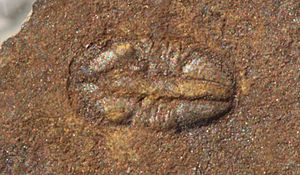Pagetia facts for kids
Quick facts for kids Pagetia |
|
|---|---|
 |
|
| A heavily eroded specimen of Pagetia taijiangensis, 6mm, from Kaili, Guizhou, China | |
| Scientific classification | |
| Kingdom: | |
| Phylum: | |
| Class: | |
| Order: |
Agnostida
|
| Suborder: |
Eodiscina
|
| Family: |
Pagetiidae
|
| Genus: |
Pagetia
Walcott, 1916
|
| species | |
|
|
| Synonyms | |
|
Eopagetia, Mesopagetia |
|
Pagetia Walcott, 1916. is a small genus of trilobite, assigned to the Eodiscinid family Pagetiidae and which had global distribution during the Middle Cambrian. The genus contains 55 currently recognized species, each with limited spatial and temporal ranges.
Type species
Pagetia bootes Walcott, 1916, from the middle Cambrian (late Wuliuan or base Drumian) Burgess Shale fossil Lagerstätte. The species occurs with Ptychagnostus praecurrens and derives originally from the "greater phyllopod bed" of Walcott quarry on "Fossil Ridge" between Wapta Mountain and Mount Field, approxiomately 5 kilometres north of Field, British Columbia in the Canadian Rocky Mountains. The presence of Pt. praecurrens, indicates correlation with the Swedish praecurrens Biozoneone (Baltoparadoxides pinus Biosubzone, A2 of Westergård 1946, pp. 98–100 ) in the upper part of the oelandicus Superzone.
Taxonomy
Order: Agnostida Salter, 1864. Suborder: Eodiscina Kobayashi, 1939. Family: PAGETIIDAE Kobayashi 1935. Genus: Pagetia Walcott, 1916. (op. cit.).
Species previously assigned to Pagetia
- P. attleborensis = Hebediscus attleborensis
- P. jinnanensis = Sinopagetia jinnanensis
- P. maladensis = Macannaia maladensis
- P. medicinalis (plant, Rutaceae) = Bosistoa medicinalis
- P. monostylis (plant, Rutaceae) = Bosistoa medicinalis
Description
A genus of the Family Pagetiidae and mainly differentiated from members of the Eodiscidae in having eyes and proparian facial sutures. In the type species, Pagetia bootes Walcott, 1916, there is a well-defined preglabellar median furrow separating the genae. Glabella is well defined, tapers slightly forward and has a well developed spine extending rearwards from the glabella. Anterior border is crenulated, which is common amongst both Eodiscidae and Pagetiidae. No genal spines. Thorax of two segments; pleurae fulcrate with anterior pleural tips pointing backwards and those of the posterior segment directed forwards to enable enrolment. Pygidial axis is well defined, reaching or overhanging the posterior border, usually with five rings and commonly extending backwards into a prominent postaxial spine.
The hypostome is a convex subquadrate plate, positioned directly under frontal part of the glabella. It is comparable to the hypostoma of other trilobites and provides an argument that Agnostida can be regarded as specialized, simplified trilobites.
Ecology
Several species of Pagetia are known from the Burgess Shale. 1022 specimens of Pagetia are known from the Greater Phyllopod bed, where they comprise 1.94% of the community. and its remains have been found in the otherwise-empty tubes of the polychaete worm Selkirkia.

